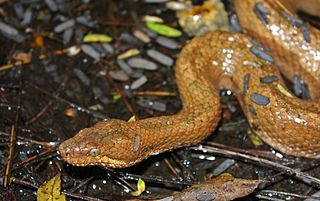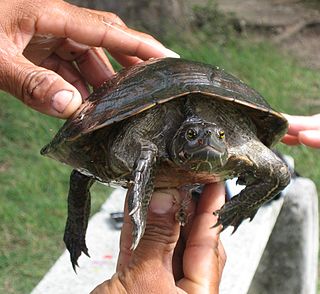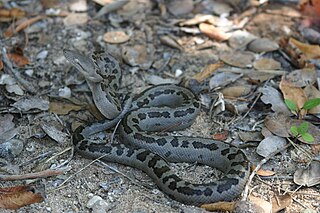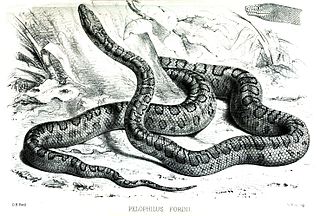
Tropidophis melanurus, commonly known as the dusky dwarf boa, Cuban wood snake, or Cuban giant dwarf boa, is a nonvenomous dwarf boa species found mainly in Cuba. There are three subspecies that are recognized as being valid, including the nominate subspecies described here.

Tropidophis, common name wood snakes or West Indian wood snakes, is a genus of dwarf boas endemic to the West Indies and South America. Currently, either 17 or 33 species are recognized, depending on the authority.
Tropidophis bucculentus, also known commonly as the Navassa Island dwarf boa, is a nonvenomous dwarf boa species endemic to Navassa Island in the Caribbean Sea. There are no subspecies that are recognized as being valid.
Tropidophis greenwayi is a nonvenomous dwarf boa species endemic to the Caicos Islands. Two subspecies are currently recognized, including the nominate subspecies described here.

The Central Antillean slider is a species of turtle in the family Emydidae. The species is found on three islands in the West Indies: Hispaniola, Great Inagua, and Puerto Rico.
Leiocephalus inaguae, commonly known as the Inagua curlytail lizard, is a species of lizard in the family Leiocephalidae.

Chilabothrus chrysogaster, commonly known as the Turks and Caicos Islands boa or the Southern Bahamas boa, is a species of snake found in the Southern Bahamas and the Turks and Caicos Islands. Local names include the rainbow boa, the Bahamas cat boa, the rainbow snake, and the fowl snake. Like all boids, it is not a venomous species.
Pholidoscelis maynardi, commonly known as the Great Inagua ameiva, Inagua ameiva, or Inagua blue-tailed lizard, is species of lizard, a member of the family Teiidae. The species is endemic to the Bahamas. Three subspecies have been described.
Vincent's least gecko is a species of lizard in the family Sphaerodactylidae. The species is endemic to the Caribbean.

Tropidophis feicki, also known commonly as the broad-banded dwarf boa, the broad-banded trope, and Feick's dwarf boa, is a species of non-venomous snake in the family Tropidophiidae. The species is endemic to Cuba.
Tropidophis nigriventis, or the black-bellied dwarf boa, is a species of snake in the family Tropidophiidae. The species is endemic to Cuba.
Tropidophis pilsbryi, commonly known as Pilsbry's dwarf boa or the Cuban white-necked dwarf boa, is a species of snake in the family Tropidophiidae. The species is endemic to Cuba.

Tropidophis taczanowskyi, also known commonly as Taczanowski's dwarf boa, is a species of snake in the family Tropidophiidae. The species is native to northern South America.
Tropidophis wrighti, commonly known as Wright's dwarf boa, the gracile banded dwarf boa, and the gracile banded trope, is a species of snake in the family Tropidophiidae. The species is endemic to Cuba.

Chilabothrus fordii, known commonly as Ford's boa or the Haitian ground boa, is a species of snake in the family Boidae.

Chilabothrus striatus, the Hispaniolan boa, is a species of snake in the family Boidae. The species is endemic to Hispaniola. The species is regularly found in the international pet trade.
Albert Schwartz was an American zoologist who worked extensively with the herpetofauna of Florida and the West Indies, and later with butterflies. One magazine article once dubbed him as one of the "Kings of West Indian Anole Taxonomy".
Caraiba is a monotypic genus of snake in the family Colubridae. The genus contains the sole species Caraiba andreae, also known commonly as the black and white racer or the Cuban lesser racer, which is endemic to Cuba. There are six recognized subspecies.

Tropidophis stejnegeri, also known commonly as Stejneger's dwarf boa and the Jamaican eyespot trope, is a small species of snake in the family Tropidophiidae. The species is endemic to the northern half of Jamaica.










